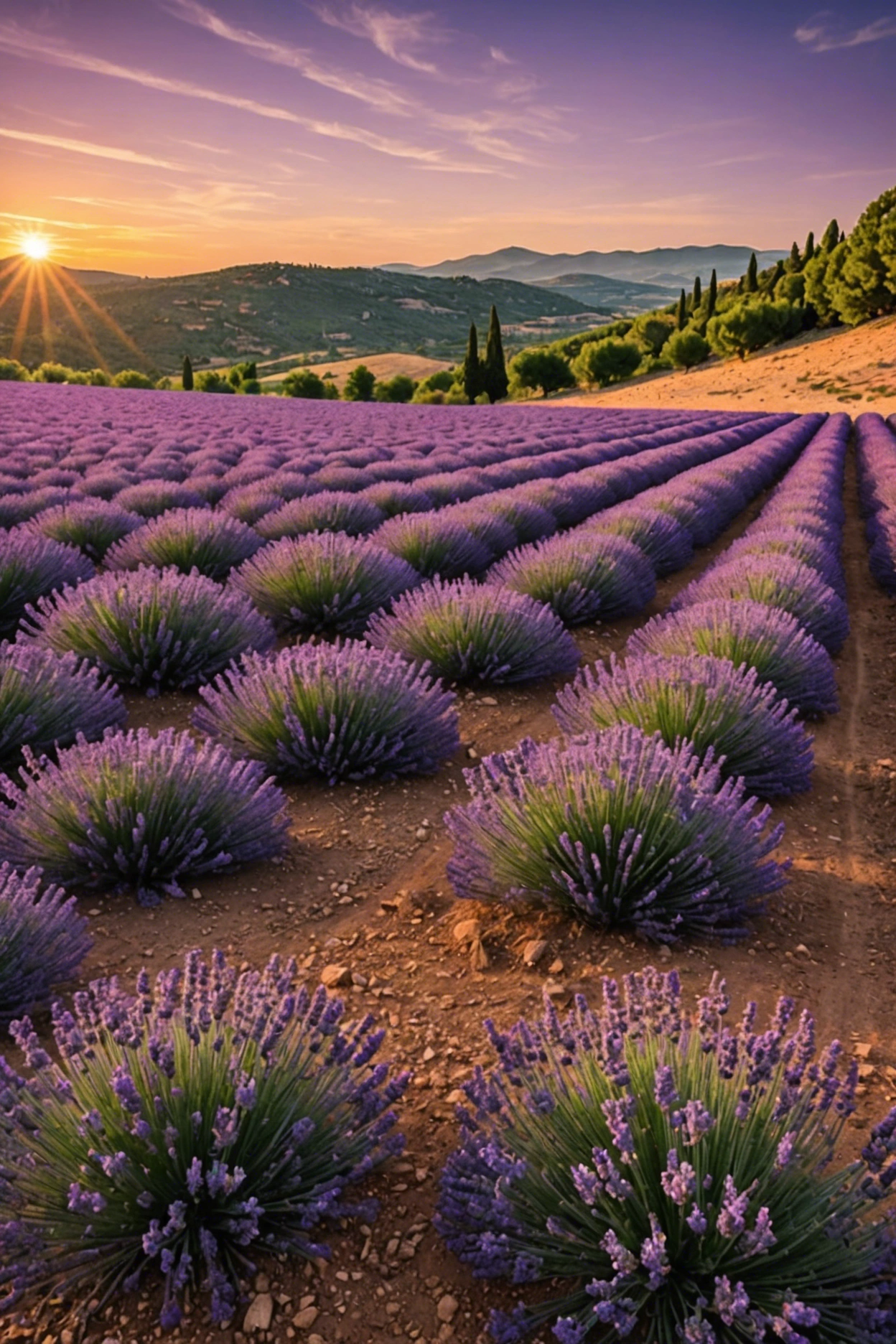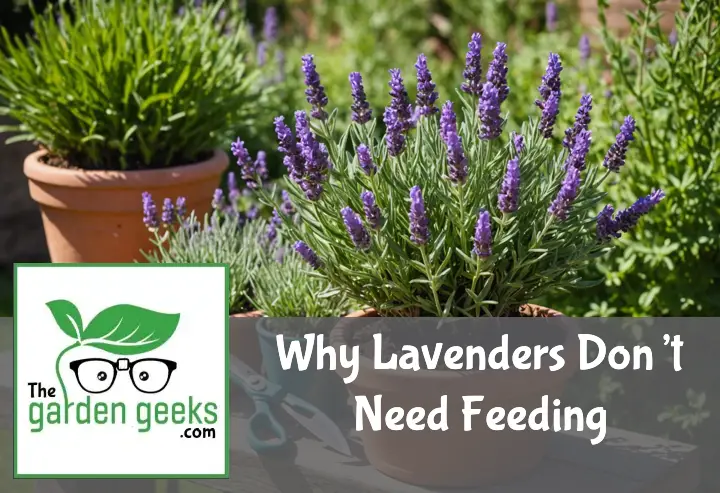Did you know that lavender plants are like the botanical equivalent of a self-sufficient hermit? Unlike many other plants, lavenders don’t rely on regular feedings to thrive. In fact, they often flourish without any additional feeding at all. This might seem surprising, but when you learn Why Lavenders Don’t Need Feeding, it all starts to make sense.
These fragrant beauties have adapted over centuries to survive in low-fertility soils. They’ve developed efficient nutrient usage and storage mechanisms that allow them to flourish where other plants would struggle.
So next time you’re tempted to sprinkle some extra fertilizer around your lavender bush, remember this: lavenders are the ultimate survivors. They’ve evolved to do more with less and they certainly don’t need us fussing over them with bags of plant food. Keep reading about Why Lavenders Don’t Need Feeding!
Quick Answer
- Lavenders don’t need additional feeding because they’re naturally adapted to low-fertility soils and use nutrients efficiently.
- The plant’s native habitat influences its nutritional needs; it thrives in typical soil conditions without frequent feeding.
- Organic matter, like decomposing mulch, provides sufficient nutrients for lavender health.
- Overfeeding can harm lavenders. Look for signs of adequate nutrition vs overfeeding to maintain a healthy plant.

Why Lavenders Thrive Without Additional Feeding
Lavenders are like the superheroes of the plant world. They don’t need much to show off their powers.
Natural Adaptation to Low-Fertility Soils
Lavenders have this cool trick. They love low-fertility soil. It’s like their superpower. This means they can grow in places where other plants might give up. Imagine trying to run a race in heavy boots, but for lavenders, it’s no problem at all.
Their roots dive deep into the ground, finding every little bit of food they need. This is why adding extra stuff to help them grow isn’t really necessary. They’ve got it covered.
In these poor soils, lavenders find their happy place. They don’t just survive; they thrive. It’s kind of like making a delicious meal out of leftovers. Lavenders make the most out of what they have.
This adaptation isn’t by accident either. Lavenders come from tough spots in nature where the soil is more about attitude than nutrients. So when we plant them in our gardens, they’re already ahead of the game.
Because of this, lavenders don’t need us to feed them extra goodies. They’re pretty independent and know how to handle infertile soils with ease.
Efficient Nutrient Usage and Storage Mechanisms
Now, let’s talk about how lavenders are so good at dealing with what they’ve got. They’re not just finding nutrients; they’re super smart about using them too.
Lavender plants have this amazing ability to take what little food there is and make it last longer than your favorite pair of jeans. This means even when nutrients are scarce, lavenders keep on blooming.
They use special nutrient storage mechanisms that are like having a pantry full of snacks for later. When times get tough, lavender plants dip into their reserves and keep growing strong.
This efficiency isn’t just about survival; it’s about thriving without needing extra help from us with fertilizers or nutrient boosts.
Their roots grab onto nutrients like a magnet and don’t let go until the plant needs them. This way, lavenders make every little bit count.
So when you think about feeding your lavender plant more than what nature offers, remember: these plants are pros at making do with less.
How Lavender’s Native Habitat Influences Its Nutritional Needs
Lavender thrives with less, thanks to where it comes from. Let’s dive into why.
Origin and Typical Soil Conditions of Lavender
Lavender calls the Mediterranean home. This region is famous for its sunny disposition and not-so-rich soils. Imagine a place where the sun always shines, but the ground is kind of stingy with nutrients. That’s lavender’s playground. This setup means lavender doesn’t get spoiled with too much food from the soil. It’s used to making do with what it has, which isn’t a lot.
The typical soil conditions for lavender are pretty lean. We’re talking about soils that don’t hold onto nutrients well. These conditions have taught lavender to be a bit of a minimalist when it comes to eating. It’s like lavender has learned to thrive on a diet that would make other plants wilt.
In these low-nutrient soils, lavender not only survives but flourishes. Its roots have gotten used to searching far and wide for what little food there is. This makes lavender one tough cookie in the plant world.
Comparison with Plants Requiring Frequent Feeding
Now, let’s talk about those high-maintenance plants always hungry for more. Unlike our laid-back lavender, some plants need constant feeding to look their best. Think of roses or tomatoes; without frequent meals, they start looking a bit sad.
These high-feeding plants are like the opposite of lavender in their native habitats. They come from places where the soil is like an all-you-can-eat buffet compared to lavender’s diet plan.
So, why don’t lavenders need as much food? It’s all about adaptation. Lavenders have evolved in tough love conditions, making them hardy and low-maintenance. They’re perfectly happy with “less is more,” while other plants might throw a fit without their nutrient-packed snacks.
This difference in plant feeding frequency shows how much environment shapes a plant’s needs. Lavender’s ability to thrive on minimal nutrition highlights its resilience and ease of care compared to more demanding green companions.



The Role of Organic Matter in Sustaining Lavender Health


Organic matter is like a superhero for lavender health. It’s all about giving the plant what it needs without going overboard.
Decomposition Process and Nutrient Release
When organic matter breaks down, it’s like a party in the soil where nutrients get released. This process is super important for lavenders because they love to soak up those goodies. Imagine tiny bits of leaves and twigs turning into a feast for your plants.
In this decomposition dance, microorganisms munch on the organic stuff, breaking it down. This releases essential nutrients that lavenders need to grow strong and healthy. It’s like the soil is cooking up a nutrient-rich meal for your plants.
These nutrients include things like nitrogen, phosphorus, and potassium – think of them as the plant version of vitamins. As these elements get released slowly, lavenders get their fill without getting overwhelmed.
The beauty of this slow release is that it matches perfectly with what lavenders need. They don’t like too much fuss or feeding, so this natural process keeps them happy and thriving.
How Organic Mulches Provide Sufficient Nutrients
Using organic mulches is like laying down a comfy blanket over your garden bed that feeds your lavenders too. These mulches break down over time, adding more goodness to the soil beneath.
This layer not only keeps moisture in but also adds nutrients back into the earth as it decomposes. It’s a win-win situation for your lavender plants because they get everything they need from just this simple addition.
Mulching with organic materials means you can skip the extra fertilizers. Your lavenders will grow strong with what nature provides through mulch decomposition. It’s an easy-peasy way to garden without extra work or chemicals.
So, when you spread that layer of organic mulch around your lavender plants, remember you’re doing more than just making them look pretty. You’re setting up a slow-release nutrient system that keeps feeding them over time without any extra effort from you.
Signs of Adequate Nutrition vs. Overfeeding in Lavender
| Signs of Adequate Nutrition | Signs of Overfeeding |
|---|---|
| Healthy green leaves | Yellowing or browning leaves |
| Strong, upright stems | Weak, drooping stems |
| Regular blooming cycle | Delayed or no blooms |
| Deep lavender color flowers | Pale or discolored flowers |
| Normal growth rate | Rapid, uncontrolled growth |
| No signs of disease or pests | Increased susceptibility to disease and pests |
| Leaves are firm and resilient | Leaves are soft and wilted |
| Root system is strong and well-developed | Root system is weak and underdeveloped |


To Wrap Up
We’ve learned that lavenders are hardy plants that don’t need feeding. They thrive in poor, well-drained soil and plenty of sunlight.
Over-feeding can actually harm these resilient beauties, leading to weak growth and fewer flowers. So, let’s allow nature to do its thing!
For more on Why Lavenders Don’t Need Feeding, check out our detailed post. Remember, less is more when it comes to caring for your lavender plants!
Question
What are some signs that my lavender plant is getting too many nutrients?
Answer
Overfed lavenders may exhibit symptoms like yellowing leaves, weak or rapid growth, and reduced flowering. Too much fertilizer can also make the plant more susceptible to disease and pests.
Question
Can I use compost as a type of organic mulch for my lavender plants?
Answer
Yes, compost can be an excellent organic mulch for lavenders. It slowly releases nutrients into the soil and helps retain moisture, which benefits the plant’s overall health.
Question
How often should I water my lavender if it doesn’t need feeding?
Answer
Lavender prefers dry conditions and needs less watering than many other plants. Watering once or twice a week should be sufficient, but always check the soil’s moisture level first.
Question
Does this mean all types of lavender don’t need feeding?
Answer
While most varieties of lavender are adapted to low-fertility soils, some hybrids may have slightly higher nutritional needs. Always research your specific variety’s requirements.
Question
If I shouldn’t feed my lavender, what else can I do to ensure its health and longevity?
Answer
Besides using organic mulch, you can ensure your lavender’s health by providing plenty of sunlight, maintaining good airflow around the plant, pruning regularly, and ensuring well-drained soil conditions.
Question
Can overfeeding harm my lavender plant in any way? If so, how can I reverse the damage?
Answer
Yes, overfeeding can harm your lavender by causing nutrient imbalances or burn roots. To reverse this condition, stop fertilizing immediately and water thoroughly to flush out excess nutrients.


